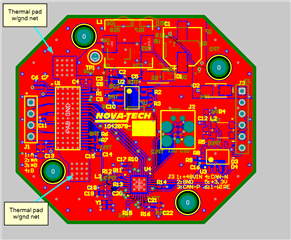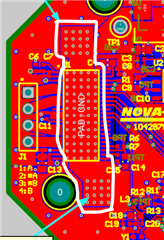Hi,
I'm experiencing overheating with our assembly when running at these parameters:
Step Rate = 1/256
Run Current = 60%
Standby Current = 20%
Standby Current Delay = 100ms (after 100ms, current goes to Standby Current)
Velocity = 60RPM
Acceleration/Deceleration = 100 RPM/s
The assembly was overheating (80C) after 1/2 hour of running at a duty cycle of 33%. It was changed to roughly 14%...3 seconds off and 5 seconds on. Afterwards, it seemed stable at roughly 56C.
Our layout looks like this with it being 4-layer (ground and power as the 2 internal layers). The top is flooded with poured power planes...layer 2 is ground...layer 3 is split power planes...layer 4 is flooded with a remaining ground plane.
We even added additional areas (w/o soldermask) for an external heatsink to pull heat from both the blank and driver (using thermal pad). ...and still, we're overheating using 1oz copper for all layers. We have the eval board for this driver and it does get a little warm but not hot like our little board does. Am I struggling with the amount of copper being used to dissipate heat does one think or could there be an issue with how we're driving it (a little rhetorical since you don't know our specifics)...but any help/advice is greatly appreciated! Please ask any follow-up questions you may think of.






